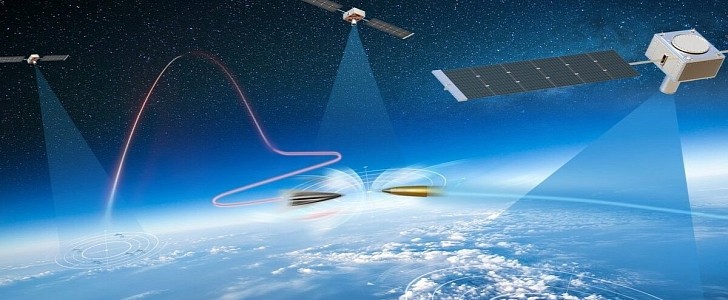Northrop Grumman has recently announced that it completed a critical design review of a prototype of the U.S. Hypersonic and Ballistic Tracking Space Sensor (HBTSS). Once in space, the HBTSS satellite will be part of a network capable of detecting and tracking ballistic and hypersonic threats.
Several nations are already working to develop hypersonic weapons. And while they’re focusing on producing rockets that can travel at supersonic speeds, defending against these incredibly-fast weapons is also a top priority. This is why U.S. Missile Defense Agency (MDA) plans to implement hypersonic weapon tracking satellites as part of its defense systems.
The HBTSS satellites will be part of a hypersonic tracking layer made up of hundreds of satellites located in Earth’s low orbit that will communicate with one another to identify and track enemy weapon systems. They will identify and track the weapons by sensing heat signatures.
They will offer continuous tracking and handoff to help services track enemy missiles launched from land, sea, or air. HBTSS satellites are also capable of tracking threats with near-global reach when utilizing infrared sensors before they even get to be detected by U.S. ground-based defenses.
Earlier this year, Northrop Grumman was awarded a $153 million contract by the MDA for the Phase IIB section of the HBTSS program, which will expand on work completed by the industry through design. The recent critical design review demonstrates that the agency is on track with the development of the HBTSS prototype.
“This critical design review puts Northrop Grumman on track to deliver a vital component of our missile defense architecture to keep the U.S. and its allies safe against hypersonic threats,” said Sarah Willoughby, Northrop Grumman vice president.
Northrop Grumman expects delivery for the HBTSS prototype to take place in 2023. Following the delivery of the HBTSS prototype, the company will conduct an on-orbit test to demonstrate the satellite’s capability to continuously track hypersonic threats and its ability to communicate the information so that the missile is intercepted.
The HBTSS satellites will be part of a hypersonic tracking layer made up of hundreds of satellites located in Earth’s low orbit that will communicate with one another to identify and track enemy weapon systems. They will identify and track the weapons by sensing heat signatures.
They will offer continuous tracking and handoff to help services track enemy missiles launched from land, sea, or air. HBTSS satellites are also capable of tracking threats with near-global reach when utilizing infrared sensors before they even get to be detected by U.S. ground-based defenses.
Earlier this year, Northrop Grumman was awarded a $153 million contract by the MDA for the Phase IIB section of the HBTSS program, which will expand on work completed by the industry through design. The recent critical design review demonstrates that the agency is on track with the development of the HBTSS prototype.
“This critical design review puts Northrop Grumman on track to deliver a vital component of our missile defense architecture to keep the U.S. and its allies safe against hypersonic threats,” said Sarah Willoughby, Northrop Grumman vice president.
Northrop Grumman expects delivery for the HBTSS prototype to take place in 2023. Following the delivery of the HBTSS prototype, the company will conduct an on-orbit test to demonstrate the satellite’s capability to continuously track hypersonic threats and its ability to communicate the information so that the missile is intercepted.

